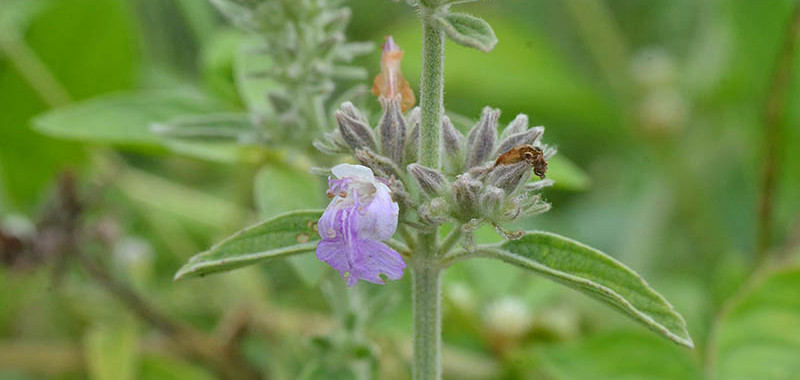Anisomeles malabarica (Lamiaceae) - Malabar Catmint
- Das K

- Nov 4, 2022
- 4 min read
Updated: Nov 7
(Malabar Catmint)
1. Taxonomic insights
Species: Anisomeles malabarica
Family: Lamiaceae
Genus: Anisomeles
Related Herbs from the same family:
Ocimum tenuiflorum (Tulsi, Holy Basil): The "Queen of Herbs" in Ayurveda, used for its adaptogenic, immunomodulatory, and anti-infective properties.
Mentha spicata (Pudina, Spearmint): A common culinary and medicinal herb used for its cooling, carminative, and digestive properties.
Leucas aspera (Thumbai, Dronapushpi): A widely used folk medicine for skin diseases, coughs, colds, and as an insect repellent.
Coleus amboinicus (Panikoorka, Indian Borage): A South Indian remedy for cough, cold, fever, and digestive issues in children.
2. Common Names:
Scientific Name: Anisomeles malabarica | English: Malabar Catmint | Sanskrit: Sphotah, Sphotaghni | Hindi: Chodhara, Gopali | Tamil: Peyimarutti, Karu thumbai | Telugu: Mokka benda, Gobbari tulasi | Kannada: Kadu golipa, Heggurutu | Malayalam: Karimthumba, Peythumba | Marathi: Gopali, Gopahaldi | Bengali: Gopali |
3. Medicinal Uses:
Antipyretic (fever-reducing), Diaphoretic (induces sweating), Halitosis (Foul breath), Carminative (relieves gas), Antispasmodic, Anti-inflammatory, Antimicrobial, Insecticidal; Repels mosquitoes and kills larvae of mosquito .
Unverified Medical Claims: Helps with Gout, Epileptic fits, For Allergies, Intestinal worms, and Anticancer.
4. Phytochemicals specific to the plant and their action.
Essential Oil: The oil contains compounds like β-Caryophyllene, Caryophyllene Oxide, and α-Humulene. These terpenes are responsible for the plant's strong Antimicrobial, Anti-inflammatory, and Insecticidal actions.
Flavonoids: Including Apigenin, Luteolin, and their glycosides. These provide Antioxidant and Anti-inflammatory benefits, supporting the body's defense during fevers and infections.
Diterpenoids: Such as Anisomelic Acid. These compounds have demonstrated significant Antispasmodic and Anti-inflammatory activities, explaining its use in colic and pain.
Phenolic Acids: Including Caffeic and Rosmarinic acid (common in Lamiaceae). These are potent antioxidants with antimicrobial and anti-inflammatory properties.
5. Traditional and Ethnobotanical uses covering the Medicinal uses.
Antipyretic and Diaphoretic for Fevers
Formulation: Leaf decoction.
Preparation & Use: A decoction of the leaves is consumed to treat intermittent fevers, such as those seen in malaria. It is often given at the onset of a fever to induce sweating and break the fever.
Reasoning: The essential oils and diterpenoids work together to stimulate circulation and sweating (diaphoresis), which helps to cool the body and eliminate toxins. The Anti-inflammatory and Antimicrobial compounds help fight the underlying infection.
Carminative and Antispasmodic for Digestive Issues
Formulation: Leaf juice or decoction.
Preparation & Use: The juice of fresh leaves or a warm decoction is administered to relieve flatulence, intestinal colic, abdominal pain, and diarrhea.
Reasoning: The essential oil and diterpenoids (like Anisomelic Acid) have Carminative and Antispasmodic effects, relaxing the smooth muscles of the gut and easing cramping and gas.
Topical Application for Skin Infections and Rheumatism
Formulation: Leaf paste or essential oil dilution.
Preparation & Use: The paste of the leaves is applied on skin diseases like scabies, eczema, and allergic rashes. The leaves are also boiled in water, and the steam is fomented over rheumatic joints for pain relief.
Reasoning: The potent Antimicrobial essential oils help combat skin infections, while the Anti-inflammatory compounds reduce joint inflammation and skin irritation.
6. Healing recipes, Medicated Oils, Teas and Culinary uses (if any).
This herb is primarily medicinal and not a common culinary item due to its strong, pungent aroma.
Digestive Tea
Purpose: To relieve gas, bloating, and mild abdominal cramps.
Preparation & Use:
Crush a few fresh leaves (about 5-7).
Steep them in a cup of hot water for 5-7 minutes.
Strain and sip slowly after a heavy meal.
Fever-Breaking Decoction
Purpose: To reduce high fever, especially of an intermittent nature.
Preparation & Use:Take a handful of fresh Anisomeles malabarica leaves. Boil in 1.5 cups of water for 5-7 minutes. Strain and drink while warm. A small piece of ginger can be added to enhance the diaphoretic effect.
Steam Inhalation for Respiratory Congestion
Purpose: To relieve sinusitis and bronchial congestion.
Preparation & Use:A handful of leaves are added to a pot of boiling water. The patient leans over the pot, covers their head with a towel, and inhales the medicated steam for 5-10 minutes.
Medicated Oil for Joint Pain
Purpose: For external massage to relieve rheumatic and arthritic pain.
Preparation & Use:
Take a sufficient quantity of fresh leaves and dry them in the shade.
Heat sesame or coconut oil in a pan and add the dried leaves.
Fry on low heat until the leaves turn crisp.
Strain the oil and store it in a bottle. Use it for daily massage on affected joints.
7. Disclaimer:
Anisomeles malabarica is a powerful medicinal herb. Its essential oil is potent and should not be ingested undiluted. Due to its strong physiological effects, it should be used in moderation. Pregnant and lactating women should avoid its use due to a lack of safety data. Always consult with a qualified practitioner before using it for therapeutic purposes. This information is for educational purposes only.
-x-x
8. Reference Books, Books for In-depth Study:
Indian Medicinal Plants by K.S. Kiritkar and B.D. Basu
Wealth of India - Raw Materials Series by CSIR
Journal of Ethnopharmacology (for phytochemical studies)
9. Further study:
Holy Basil (Tulsi): Scientific name: Ocimum tenuiflorum. Family: Lamiaceae. Shares a family and many properties, including antipyretic, anti-inflammatory, and antimicrobial actions. Tulsi is more focused on adaptogenic and respiratory health, while Anisomeles is notably strong for fevers and spasms.
Indian Borage (Panikoorka): Scientific name: Coleus amboinicus. Family: Lamiaceae. A classic home remedy in South India for children's fevers and coughs, providing a functional parallel to Anisomeles in managing pediatric ailments.
-x-x-x-End-x-x-x









Comments